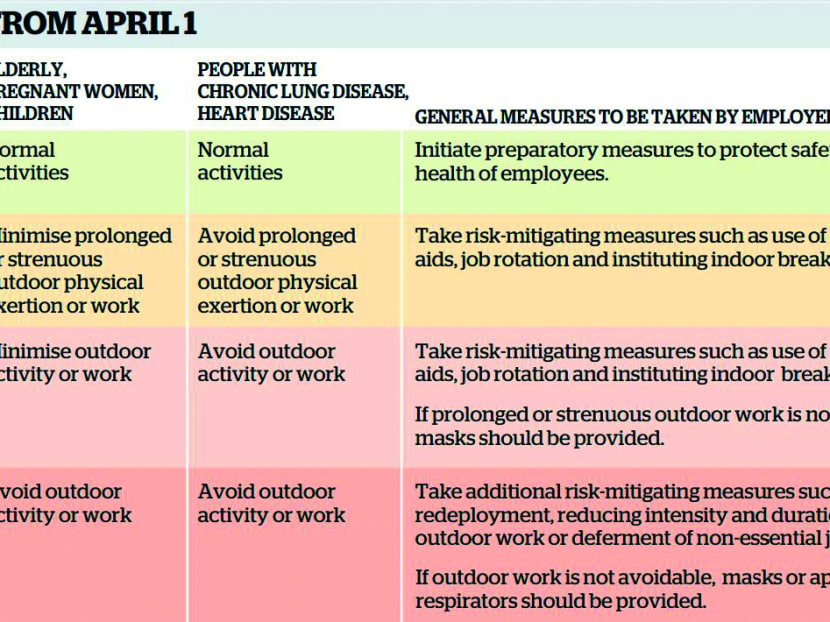New air quality reporting system from April 1
SINGAPORE — The new air quality reporting system — which will come into effect on April 1, one month ahead of schedule — will better reflect visibility levels during a haze, as it will incorporate levels of fine particulate matter, or PM2.5, into the Pollutant Standards Index (PSI).
SINGAPORE — The new air quality reporting system — which will come into effect on April 1, one month ahead of schedule — will better reflect visibility levels during a haze, as it will incorporate levels of fine particulate matter, or PM2.5, into the Pollutant Standards Index (PSI).
In other words, the new three-hour PSI, which will be based on PM2.5, will pass the “window test”, as an official from the National Environment Agency (NEA) put it yesterday.
During the severe bout of haze last year, there was criticism from some members of the public that the PSI readings did not correspond with what they saw outside their windows.
The new reporting system was announced in Parliament last week by Dr Vivian Balakrishnan, Minister for the Environment and Water Resources, during his ministry’s Committee of Supply debate.
Yesterday, Dr Balakrishnan said at a press conference that the Government will bring forward the roll-out of the new system in view of the earlier onset of hazy conditions this year. While the showers that Singapore experienced over the past few days have improved air quality, he said this might be temporary as slash-and-burn activities in Indonesia had begun earlier this year than in the past.
He said: “The haze in Riau that was present two weeks ago was worse than it was last year — that means the fundamental economic forces that lead to illegal clearing of land and deforestation through burning are still present.”
Nevertheless, he noted that Indonesian President Susilo Bambang Yudhoyono had recently gone to Riau to address the situation. He said: “If they take his instructions seriously, maybe, we can hope for a better situation.”
The new PSI will be based on the worst of six pollutants — sulphur dioxide, ozone, nitrogen dioxide, carbon monoxide, PM10 and PM2.5 — to give a better picture of Singapore’s overall air quality. The NEA will report the three-hour PSI based on PM2.5, instead of PM10 (particulate matter with a diameter below 10 micrometres) to satisfy the “window test” in periods of smoke haze, said its Chief Scientific Officer Indrani Rajaram.
Hourly updates on PM2.5 levels in the air will also be published, so the public can take necessary precautions.
An NEA spokesperson said the three-hour PM2.5 readings will reflect more recent levels of PM2.5 and should “correspond more closely with what one sees”, as finer particles in PM2.5 scatter more light.
National University of Singapore air-pollutants expert Jason Blake Cohen said some of such fine particulate matter also absorb light, thus reducing visibility. Asst Prof Cohen said the new method of deriving PSI should give the public more clarity and confidence, as it is a widely accepted standard that can make it easier for Singaporeans to compare air quality with other cities in the world.
The NEA spokesperson said that, while the three-hour PSI might be useful to help the public decide whether to proceed with or postpone their immediate activities, it is not as useful in helping to plan for activities to be held later, such as the next day. “For this, the public may wish to take reference from the haze forecast issued by the NEA based on the 24-hour PSI.”
Under the new reporting system, the Republic may experience many more days of “moderate” air quality, despite the air being no more polluted than in the past. Accordingly, the Health and Manpower ministries have refined, respectively, the haze health advisories and workplace guidelines for employers.
Representatives from both ministries and the Ministry of Education reiterated that contingency plans are in place, should the haze return.
On whether a stop-work order will be issued if the haze reaches a certain level, Dr Balakrishnan reiterated that while the health and safety of Singaporeans are the priority, the country cannot “shut down totally in the face of haze”. He noted that the authorities have the power to intervene if an employer is not behaving responsibly and ensuring the safety of workers.
Dr Balakrishnan said that, compared with last year, when the PSI reading hit a record 401, he is confident the Government is “far more prepared and ... will be able to ride through” the situation should the haze worsen this year. With the Government, retailers and People’s Association having stockpiles of masks, he said this should “not be a point of anxiety”.
While the North-east Monsoon has kept haze from Sumatra away from Singapore, the coming inter-monsoon season with lighter and variable winds and the South-west Monsoon, which typically begins in June, could lead to haze coming in Singapore’s direction.
“We still have to be on guard against the recurrence of haze,” said Dr Balakrishnan.








